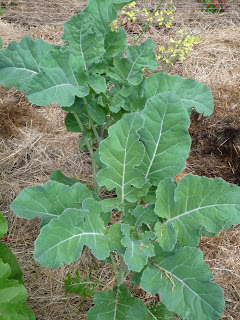 |
| Bulbless kohlrabi |
My broccolis may still turn out to be a success, but I'm going to have to wait till next spring to find out, because they didn't get big enough to flower before the day length started to get shorter, and I think they just decided to wait till next year. They got really big, chest high and 18" across. Yesterday they both fell over:
 |
| Recumbent broccolis |
The zucchini I had problems with early in the spring, with blossom end rot. I didn't know squash could get that, but I learned it's a problem in many cucurbits—squashes—including zucchini. It can be caused not just by insufficient calcium in the soil, but a number of other problems that keep the plant from being able to get enough calcium, even though the soil is fine. Among those are cold soil, and insufficient or irregular water. I know the water there has been hard to manage this year and I'm going to put them in a better spot and handle the watering differently next year. I've gotten 3 zukes off of it so far and there's one more on there now, but the clouds are coming in, the temperatures are going to be getting cooler soon, and I think this last one is going to be the end.
My big success was the peas—so many I could hardly keep up with them for a while:
 |
| Peas are just too cute |
My potatoes were the size winners—in fact, they got too big. I planted them in north-south rows, and they all ended up falling over and smothering whatever was east of them—garlic and onions, beans, fennel and squash. So next year I won't be planting quite as many, and I'll plant them in east-west rows, so they'll just fall over on each other. I did talk to a woman who grew potatoes in straw over in Bend, and she put 18" of straw on top of hers as they grew up. That would probably help keep them upright. The only ones that have died back completely have been the All Blues, and I've been pulling them out of the ground for the last week one or two at a time. I've gotten 4 so far from one plant, and have just been amazed at how much flavor they have. With olive oil and garlic salt on them, they're like the best potato chip I've ever eaten. Awesome.
This morning the other two rows, the Pontiac reds in front and the Rose Finn Apple Fingerlings on the upper right, are obviously winding down. The Pontiacs were 18" tall a month ago and 3 feet across (I'm not kidding), now they're only a few inches tall and you can see how much they've thinned out:
 |
| Tired potatoes and mildewy squash |
I don't have a picture of my garlic, either, but it did well for only being planted this spring. I dug up a couple little 3-5 clove heads two weeks ago to make garlic toast out of them, and they were great! I figure I'll just leave them in the ground, and maybe plant another 10 or so next month—when they're supposed to be planted! The onions I don't know about yet--they're under the potato plants, so I'll be able to get to them soon. The rhubarb grew really well all year, except they had some water problems too at one point. But I think I'll be able to get a good harvest from them next spring, most of the plants developed 6 stalks or more this year.
One other bit of garden eating I got to do was when I made the garlic toast, I garnished them with chopped sage and rosemary from my garden—and some store-bought parsley. Next year I'm definitely going to grow some parsley! Parsley, sage, rosemary and garlic—mmmmmmm!
As far as the hay mulch is concerned, as a weed supressant and a moisture retainer it worked really great. The places that got too dry were places where I didn't have enough hay down. I did end up having to water 2-3 times a week when it got hot. Next year I'll try to do a better job of getting both the hay and the water distributed evenly. I also need to either get a different kind of sprinkler or use a soaker, or plant my plants better. The broccoli got so tall it ended up blocking the water to the rhubarb. The zucchini didn't have enough hay around it, but by the time I discovered that, the potatoes were overtaking both squash plants and it was really hard to get to anything.
I had one other success, that I haven't done anything with this year except enjoy looking at them—the cardoons:
 |
| Cardoon |
One more treat that's coming, if the deer don't jump in and eat them before they're ripe next month:
 |
| Liberty apple |
And one more treat that's technically outside the Ruth Stout garden, although I do mulch it with bark:
 |
| Canadice grapelets |
So all in all, it's been a really interesting year, and a really interesting garden. I love Ruth Stout! I love hay mulch! I love my garden!













































